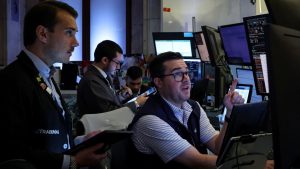There have been ups and downs, but over time America’s S&P 500 has proved itself a top destination for investors seeking tremendous returns.
Since 2010, the share index has delivered an average annual return of almost 14%. Returns during this time have been supercharged by its large contingent of high-growth tech stocks like Nvidia, Microsoft and Tesla.
But doubts are creeping in as to whether the S&P 500 can maintain its record. This follows plans by US President Donald Trump to impose potentially crushing trade tariffs on major trading partners.
What does this mean for investors?
Stark warning
Scanning the financial pages this morning (17 February), I was drawn to an interview with Nobel prize-winning economist Joseph Stiglitz.
Discussing potential US tariffs and reciprocal taxes from trade partners, he said that “it risks the worst of all possible worlds: a kind of stagflation.”
Stiglitz said that uncertainty related to Trump’s trade plans would slow economic growth, while new tariffs could also push up costs for business and consumers.
He commented that “how much it will increase prices is a little bit affected by the magnitude of the appreciation of the exchange rate, but all economists think that the extent of the appreciation of the exchange rate won’t be anywhere near enough to compensate for the tariffs.“
Don’t panic yet
Investors need to be extra careful in this climate. However, I feel there’s also no need for them to panic.
First, there’s no guarantee that new trade rules will come into place. Trump’s decision to delay tariffs on Mexico and Canada last month indicates room for manoeuvre.
There’s another important thing to remember. While economists like Stiglitz deserve attention, we’ve seen many times before that predictions of doom and gloom can be overstated.
So, is the S&P 500 still an attractive place to consider investing? I think so, which is why I plan to continue holding US shares, trusts and funds.
Spreading risk
While the outlook is more uncertain today, there are still good reasons to expect S&P shares to outperform over the long term. These include:
- The robustness of the US economy.
- Further rapid growth in the digital economy that powers tech profits.
- Dominance by S&P 500 companies in major sectors like healthcare, finance and technology.
- The S&P’s large global footprint providing added earnings opportunities.
It’s also important to remember the robustness of the US stock market over time. Since its inception in 1957, the S&P 500 has overcome multiple crises — including wars, recessions, pandemics and political turmoil — and has hit new record highs in 2025 despite tariff worries.
However, cautious investors may wish to consider buying an index-tracking exchange-traded fund (ETF) as well as purchasing individual shares today. The HSBC S&P 500 ETF (LSE:HSPX) is one I hold in my own portfolio.
By investing in hundreds of different companies, the fund helps investors manage a low-growth scenario through holdings in cyclical and non-cyclical businesses. It also includes industries that are less vulnerable to inflationary pressures, like consumer staples and healthcare.
Finally, the fund limits exposure to sectors that could be directly impacted to a large degree by trade tariffs, such as the car industry and agriculture.
This HSBC product isn’t immune to economic volatility. But over the long term, I still believe it could continue delivering excellent returns.
This post was originally published on Motley Fool




